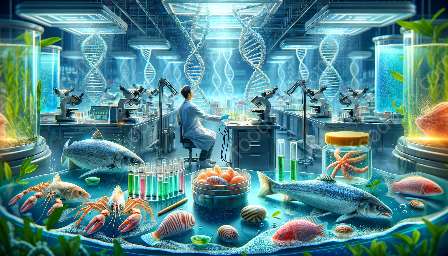Seafood species play a crucial role in the global food industry, providing essential nutrients and contributing significantly to the economy. As the demand for seafood continues to rise, the development of breeding programs has become increasingly important. These programs focus on enhancing the genetic traits of various seafood species to improve their growth, disease resistance, and overall quality. Additionally, advancements in seafood biotechnology and genetic improvement have revolutionized the way we approach the cultivation and breeding of seafood species.
Understanding Seafood Biotechnology
Seafood biotechnology encompasses the application of scientific principles and techniques to manipulate the genetic makeup of seafood species. This encompasses methods such as selective breeding, genetic engineering, and reproductive technologies, with the aim of advancing desirable genetic traits. Through the integration of biotechnological tools, researchers and aquaculture professionals can effectively enhance the performance and sustainability of seafood production.
Genetic Improvement in Seafood
Genetic improvement represents a critical aspect of breeding programs for seafood species. By identifying and selectively breeding individuals with superior genetic characteristics, such as faster growth rates, increased disease resistance, and improved feed conversion, aquaculture practitioners can produce offspring with enhanced traits. Furthermore, the use of molecular genetics has enabled precise genomic selection and assisted in accelerating the breeding process.
The Science of Seafood
At the core of breeding programs and genetic improvement in seafood lies the extensive scientific research that informs these practices. Seafood science encompasses a wide array of disciplines, including genetics, microbiology, nutrition, and ecology, all of which contribute to a comprehensive understanding of seafood species. By leveraging the principles of seafood science, breeders can effectively develop strategies to optimize the genetic potential of various species, ensuring sustainable and efficient production methods.
Advancements in Breeding Programs
The field of breeding programs for seafood species has witnessed remarkable advancements, driven by innovations in biotechnology and genetic improvement. Through the integration of cutting-edge technologies such as CRISPR-Cas9 gene editing, researchers can target and modify specific genes, offering unprecedented control over the genetic traits of seafood species. Additionally, the utilization of advanced reproductive technologies, including artificial insemination and cryopreservation, has expanded the scope of breeding programs, enabling the preservation and propagation of valuable genetic lineages.
Integrated Approaches in Seafood Research
Modern breeding programs for seafood species are characterized by an integrated approach that harnesses the synergies between biotechnology, genetic improvement, and seafood science. This multidisciplinary strategy involves the collaboration of geneticists, biotechnologists, nutritionists, and aquaculture experts, pooling their expertise to drive innovation and sustainability within the seafood industry. By embracing a holistic approach, breeding programs can address complex challenges such as disease susceptibility, environmental adaptation, and nutritional efficiency.
Future Prospects and Sustainability
The convergence of breeding programs, biotechnology, and genetic improvement holds immense promise for the future of seafood production. As global demand for seafood continues to expand, it is imperative to develop sustainable breeding strategies that prioritize genetic diversity, ecological resilience, and ethical considerations. Furthermore, ongoing research into novel biotechnological applications and genomic resources promises to unlock new avenues for enhancing the productivity and resilience of seafood species, ensuring a secure and sustainable supply for future generations.

